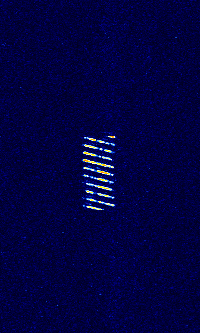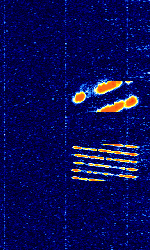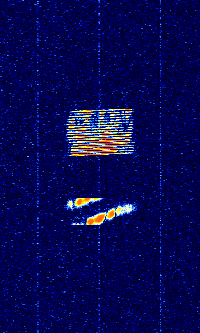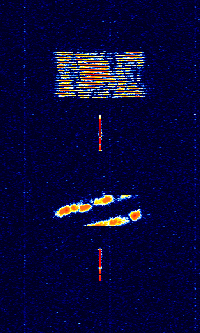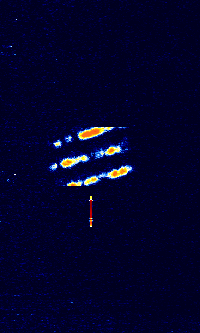Relocatable Over-the-Horizon Radar (ROTHR)
| Radars | |
|---|---|
| Military: 🇮🇷 🇷🇺 'Ghadir' OTH Radar (Iran/Russia "Rezonans") - 🇷🇺 29B6 'Kontayner' OTH Radar (Russia) - 🇷🇺 Podsolnukh 'Sunflower' Radar (Russia) - 🇨🇳 Chinese 'Foghorn' OTH radar (China) - 🇨🇳 'OTH-SW' OTH Radar (China) 🇦🇺 Jindalee Operational Radar Network (JORN) (Australia) - 🇨🇾 🇬🇧 PLUTO II OTH Radar (Cyprus/UK Base) - 🇺🇸 Relocatable Over-the-Horizon Radar (ROTHR) (US) Civil: 🌎 🌊 CODAR (Worldwide) - 🇺🇸 High Frequency Active Auroral Research Program (HAARP) (Alaska, US) *VHF |
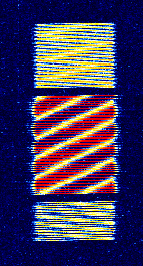 | |
|---|---|
| Frequencies | 5 MHz,28 MHz |
| Frequency Range | 5 MHz - 28 MHz |
| Mode | USB |
| Modulation | FMCW |
| ACF | — |
| Emission Designator | — |
| Bandwidth | 4 kHz,8 kHz,16 kHz,50 kHz,100 kHz |
| Location | United States |
| Short Description | Relocatable Over-the-Horizon Radar (ROTHR), also known as AN/TPS-71, is an OTH Radar used by the United States Navy that uses bistatic ionospheric backscattering for wide area surveillance. |
| I/Q Raw Recording | Download file |
| Audio Sample | |
Relocatable Over-the-Horizon Radar (ROTHR), also known as AN/TPS-71, is an OTHOver The Horizon (very long range) Radar used by the United States Navy that uses bistatic ionospheric backscattering for wide area surveillance. The Radar system was developed by the US Navy with assistance from Raytheon. Three ROTHR systems are in use, in Virginia, Texas and Puerto Rico.
The radar uses FMCW transmission and can use different bandwidths. Lower bandwidth transmissions are easier to receive in distant locations such as Europe. Transmission happens in bursts and a couple of successive bursts are often transmitted. After transmitting a burst sequence, the radar may change its frequency slightly, making it harder to follow compared to other OTHOver The Horizon (very long range) radars. Sweep rate is often changed between successive bursts. The bursts are most commonly transmitted without intro tone, and sometimes a three-part intro tone is used. This three-part intro tone is a characteristic feature of this radar.
ROTHR can be confused with the JORN radar, but can be differentiated by its different bandwidth and three-part intro tone or lack of intro tone.
Samples[edit]
In the following descriptions, the frequencies written in HzHertz (Hz), unit of frequency, defined as one cycle per second (1 Hz). are the sweep rates.
| Single burst, 25 HzHertz (Hz), unit of frequency, defined as one cycle per second (1 Hz)., no intro tone, 8 kHzKiloHertz (kHz) 10^3 Hz BW |
Two bursts, 25 HzHertz (Hz), unit of frequency, defined as one cycle per second (1 Hz). and 32 HzHertz (Hz), unit of frequency, defined as one cycle per second (1 Hz)., no intro tone, 8 kHzKiloHertz (kHz) 10^3 Hz BW |
Two bursts, 32 HzHertz (Hz), unit of frequency, defined as one cycle per second (1 Hz). and 42 HzHertz (Hz), unit of frequency, defined as one cycle per second (1 Hz)., no intro tone, 8 kHzKiloHertz (kHz) 10^3 Hz BW |
|---|---|---|
| Two bursts with three-part intro tone, 32 HzHertz (Hz), unit of frequency, defined as one cycle per second (1 Hz). and 42 HzHertz (Hz), unit of frequency, defined as one cycle per second (1 Hz)., 8 kHzKiloHertz (kHz) 10^3 Hz BW |
Single burst with different three-part intro tone, 32 HzHertz (Hz), unit of frequency, defined as one cycle per second (1 Hz)., 8 kHzKiloHertz (kHz) 10^3 Hz BW |
|---|---|
Video Examples[edit]
- US Navy AN/TPS-71 Relocatable Over-The-Horizon RADAR 8kHz
- US Navy AN/TPS-71 Relocatable Over-The-Horizon RADAR 16kHz FMCW
- US Navy AN/TPS-71 Relocatable Over-The-Horizon RADAR 50kHz FMCW
- US Navy AN/TPS-71 Relocatable Over-The-Horizon RADAR 100kHz / 4kHz FMCW
- Radar, possible US ROTHR, 8051 kHz center frequency, 100 kHz wide FMCW
